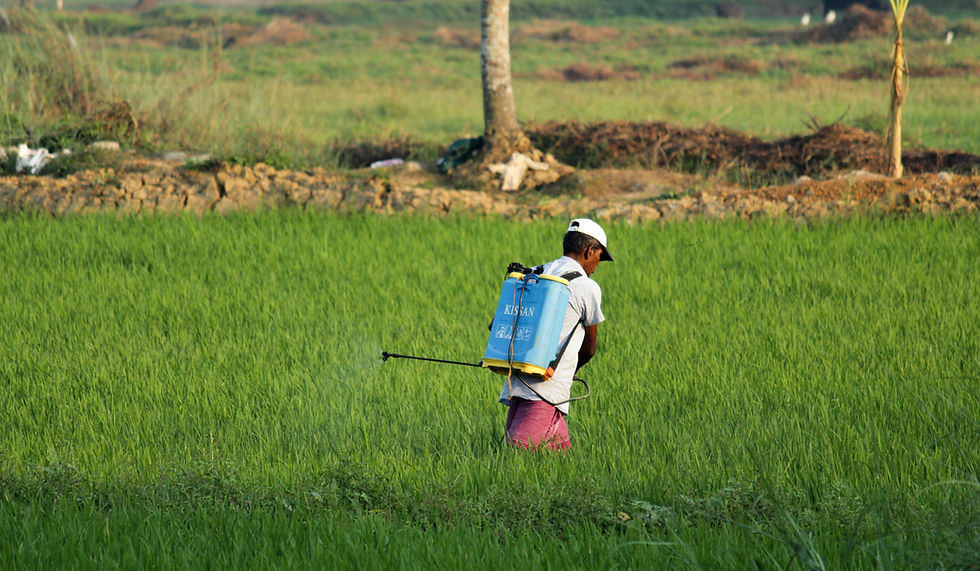The use of chemicals in agriculture has been associated with elevated risks of prostate cancer. The aim of this study was to analyze prostate cancer risk in a cohort of 20,025 pesticide applicators in agriculture licensed between 1965–1976.

Prostate cancer is one of the most common types of cancer.
Many prostate cancers grow slowly and are confined to the prostate gland, where they may not cause serious harm. However, while some types of prostate cancer grow slowly and may need minimal or even no treatment, other types are aggressive and can spread quickly.
Prostate cancer is cancer that occurs in the prostate. The prostate is a small walnut-shaped gland in males that produces the seminal fluid that nourishes and transports sperm.
Prostate cancer is the most common cancer among men in many Western countries including Sweden, and the fourth most common type of cancer among men in the world.
In 1985, approximately 300,000 men in the world were diagnosed with prostate cancer and the incidence has increased considerably in most countries during the last decade.
The most consistent findings regarding occupations at high risk involve farmers, cadmium workers, and rubber workers.
The use of agricultural chemicals, especially pesticides, has increased rapidly since the 1940s, and some are suspected of being carcinogenic. Exposure to pesticides has been associated with an increased risk of prostate cancer in farmers.
Cadmium and cadmium compounds, which occur as impurities in fertilizers and are used as active ingredients in some pesticides, are associated with prostate cancer in humans and animals. No other chemicals, groups, or mixtures predominant in occupational exposure, pesticides, or drugs have so far been associated with prostate cancer in humans or animals.

The most common pesticides were phenoxy acetic acid herbicides, organochlorine compounds (e.g., DDT, lindane, pentachlorophenol), mercury, and organophosphorus compounds. Use was considerably more frequent in the south and very scarce in the north. The use of protective clothing has, despite special training, been only slightly more frequent among pesticide applicators than among farmers in general.
Licenses for applying pesticides in agriculture became compulsory in 1965 and a majority of the applicators who had their licenses issued in 1965 or 1966 have used pesticides to a greater extent in the 1950s and 1960s compared to those who had their licenses issued in 1967– 1976.
The etiology of prostate cancer is still unclear, and the epidemiology is therefore of considerable interest, mainly because of the high and increasing incidence. Even if the main contribution is earlier detection due to new diagnostic tools, there seems to be an increased incidence, presumably depending on environmental factors.
If exposure to agricultural chemicals can influence prostate cancer risk, this should be seen among groups who are more heavily exposed. Pesticide applicators are shown to use more pesticides and hence are more exposed than farmers in general. As many as 92% of pesticide applicators have been exposed to pesticides, compared to only 40% of farmers.
However, some cohort studies conducted on chemical workers and manufacturers contain information on direct exposure to specified chemicals.
Agricultural Chemicals: Exposure to agricultural chemicals, such as pesticides and cadmium from fertilizers, has been associated with an increased risk of prostate cancer.

An early study by Henry, In 1931 found an increased incidence of prostate cancer among farm bailiffs and foremen but not among agricultural workers and farmers. Some chemicals, e.g., mercury and arsenical compounds, were used as pesticides before 1931.
Cadmium is one of the few chemicals connected with increased prostate cancer risk both in humans and animals. An association between cadmium exposure and prostate cancer was suggested in 1965 by Potts, and several studies recently reviewed support this result. Pesticide applicators are to a minor extent exposed to cadmium via the use of fertilizers, fungicides, and insecticides. Both the use and quality of fertilizers, however, are very different in various countries.
There is a weak association between exposure to agricultural chemicals such as pesticides and the risk of prostate cancer. This must, however, be interpreted cautiously since in the environment of farmers and pesticide applicators there are other potential carcinogens, e.g., exhaust fumes, solvents, or fuel oils, as well as exposure to animals and indirectly to zoonotic viruses. No studies on experimental animals involving pesticide exposure have, however, shown any signs of tumors in the prostate.
Factors- Androgens, e.g., testosterone, can influence the risk of prostate cancer. High serum levels of testosterone among young males might be associated with an elevated risk of prostate cancer. African Americans, who have the highest reported risk of prostate cancer in the world, also have 10–15% higher concentrations of circulating testosterone than their white counterparts.
The prostate is also sensitive to estrogens and there is some proof that certain pesticides organochlorine compounds such as DDT, may cause weak estrogenic activity. Both in vivo and in vitro studies confirm that TCDD and related compounds exhibit a broad spectrum of antiestrogenic effects.
BY KHAS.
.jpeg)

Comentários